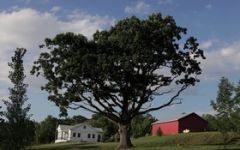Boundary Breaks Riesling Ice Wine (375ML half-bottle) 2018
-
James
Suckling -
Robert
Parker -
Wine
Enthusiast



Product Details
Your Rating
Somm Note
Winemaker Notes
Ice Wine is made from grapes left out in the vineyard to dehydrate, which causes the juices to become very concentrated. This fruit is picked when the temperatures are 15 degrees Fahrenheit or below. At these low temperature the remaining water in the juice turns into ice. When they press these frozen grapes the water stays behind in the press as ice. This yields an even more concentrated grape essence which we make into this wine.
Professional Ratings
-
James Suckling
Stunning papaya nose, then a very concentrated and succulent palate with a very vibrant finish that whips you along at a terrific clip. Drink or hold.
-
Robert Parker's Wine Advocate
The 2018 Riesling Ice Wine, made by winemaker David Breeden, was picked on January 14, 2018, and bottled on July 1, 2018. It comes in with 11.8% alcohol, 184 grams of residual sugar and 7.4 of total acidity. This, the winery is proud to point out, is a "true" ice wine—frozen on the vine, not cryogenically. The difference, they say, "is the level of concentration...prior to fermentation," which they described as 27.29 Brix for cryogenic versus close to 40 for this wine frozen on the vine. "Additionally, grapes left out in the elements turn brown and have a raisin-like quality...the 'Maillard Reaction'...converts sugars and amino acids into new compounds which are responsible for new and distinctive flavors...."
After that buildup, you expect me to tell you this is dense and concentrated and all that? Sort of. It has plenty of concentration, but we are still in the Finger Lakes. Ice Wine, actually, is often surprisingly fresh and elegant, and not just in the Finger Lakes. It does not seem either thick or cloying, but it has a perfect expression of Riesling that doesn't fade. It has all the complexity the winery mentioned. It is all about the fruit and character, although it could use a bit more depth. After two days in the fridge, it was brighter, livelier and better, every grape, seemingly, defined and expressive as it sat on the tongue. I bet this ages well, perhaps better than anticipated, but you can enjoy this incarnation right now if you must. It will be better in a couple of years and very different in ten—they are often more interesting with age and gentle oxidation. -
Wine Enthusiast
Intense aromas of star fruit, pineapple and lemon oil are pure and pristine on the nose. The lusciously sweet palate brings flavors of pithy lemon and tropical fruit drizzled in orange tinged honey. While there’s ample richness, there’s also plenty of piercing acidity to keep it lifted. Drink through 2030.
Other Vintages
2020-
Robert
Parker -
James
Suckling -
Wine
Spectator
-
Wine
Spectator
-
Robert
Parker -
Wine
Enthusiast


The vineyard site is exceptional. There are 70 acres of open farmland that had previously been planted to row crops like corn and soybeans. The soils are characterized as “Cazenovia Silt Loam” which is tested at an optimal pH typical of calcareous soils. These soils are considered ideal for producing complex aromatic white wines.

Apart from the classics, we find many regional gems of different styles.
Late harvest wines are probably the easiest to understand. Grapes are picked so late that the sugars build up and residual sugar remains after the fermentation process. Ice wine, a style founded in Germany and there referred to as eiswein, is an extreme late harvest wine, produced from grapes frozen on the vine, and pressed while still frozen, resulting in a higher concentration of sugar. It is becoming a specialty of Canada as well, where it takes on the English name of ice wine.
Vin Santo, literally “holy wine,” is a Tuscan sweet wine made from drying the local white grapes Trebbiano Toscano and Malvasia in the winery and not pressing until somewhere between November and March.
Rutherglen is an historic wine region in northeast Victoria, Australia, famous for its fortified Topaque and Muscat with complex tawny characteristics.

As the most historic wine-producing region in New York state, winemaking in the Finger Lakes area dates back to the 1820s and today as a region, accounts for 90% of the state’s total wine production.
Its narrow and deep lakes created by the movement of Ice Age glaciers create an environment similar to the classic Riesling-loving regions of Europe, namely Germany and Austria. The Finger Lakes retain summer heat that incidentally warms up cold winter air, making it fall down from the lakes’ steep slopes. When spring comes, the lakes, already cooled by cold winter weather, stave off vine budding until the danger of frost has subsided. The main lakes of the zone, that is those big enough to moderate the climate in this way, are the focal points of prime vineyard areas. They include Canandaigua, Keuka, Seneca and Cayuga.
While Riesling has fueled most of the region’s success, today Pinot Noir and Cabernet Franc enjoy some attention.
